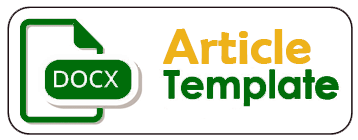PERANGKAT KOHESIF DALAM ABSTRAK ARTIKEL ILMIAH
DOI:
https://doi.org/10.32497/orbith.v13i3.1146Abstract
Sebagai sebuah genre wacana tulis yang ringkas namun mampu memberi gambaran menyeluruh tentang isi sebuah karya tulis, abstrak harus memiliki ikatan gramatika dan leksikal yang memberi makna pada gagasan yang dituangkan. Gagasan itu disebut perangkat gramatika, yang dibedakan menjadi beberapa jenis. Tulisan ini bermaksud mengidentifikasi jenis perangkat kohesif tersebut, kemudian mengidentifikasi contoh perangkat yang paling sering muncul. Enam buah abstrak digunakan sebagai sampel dalam pengidentifikasian ini. Dari hasil identifikasi diperoleh dua contoh perangkat kohesif yang paling sering
muncul, yaitu and dan this.
Key words: abstrak, moves, perangkat kohesif dan jenis.
References
Campos, J Manuel N, 2013, https://englishpost.org/2013/06/21/what-type-of-cohesive-devices-arethere/.
Hagen, Anne Scott dalam Text Cohesion, https://ndla.no/en/node/56814?fag=42.
Halliday, M. A. K., and Ruqaiya Hasan. 1976.Cohesion in English. London:Longman.
Satoso. 2009. sebagaimana dikutip dalam Cara Menulis Abstrak yang Baik dan Benar dalam http://imranbuhe.wordpres.com/caramenulis-abstrak-yang-baik-danbenar/ diunduh tanggal 12 Sept 2013.
https://unilearning.uow.edu.au/report/2bii1.html, diunduh tanggal 14 Oktober 2017.
https://student.unsw.edu.au/sample-abstracts-writing, diunduh tanggal 14 Oktober 2017.
Downloads
Published
Issue
Section
License
Authors who publish with this journal agree to the following terms:Authors retain copyright and grant the journal right of first publication with the work simultaneously licensed under a Creative Commons Attribution License that allows others to share the work with an acknowledgement of the work's authorship and initial publication in this journal.
Authors are able to enter into separate, additional contractual arrangements for the non-exclusive distribution of the journal's published version of the work (e.g., post it to an institutional repository or publish it in a book), with an acknowledgement of its initial publication in this journal.
Authors are permitted and encouraged to post their work online (e.g., in institutional repositories or on their website) prior to and during the submission process, as it can lead to productive exchanges, as well as earlier and greater citation of published work (See The Effect of Open Access).





